Israel’s largest Wastewater Treatment and Water Reuse Facility
By Molly Whalen and Kayd Bhagat
For Wildcats, purple is the color for Northwestern pride. Here in central Israel at the Shafdan Wastewater Treatment Plant, purple represents the color of pipes that contain recycled wastewater.
Today, the Trekkers ventured just outside of Tel Aviv to learn about how Israel’s Dan region recycles wastewater. Wastewater is sewage, water used for bathing, toilets, and all household functions. Here, a staggering 90% of all municipal wastewater is recycled and used in agriculture, making Israel the leader when it comes to water reclamation.
When we first arrived at the plant, we were greeted by the Lead Process Engineer, Erez Megidish, who gave us a rundown on the treatment process and showed us around the Shafdan facility. Megidish described the 5-step process wastewater takes to become high-quality water for agriculture.
First, wastewater from 2.5 million Israelis makes its way to the Shafdan facility every day where it undergoes pretreatment. Pretreatment is the process by which large solids, like sediment and sanitary wipes, are removed from the water before it is purified.
Second, the wastewater heads to the bioreactors, long flowing pools of wastewater with bacteria to help break down the organic material. After the bioreactors, the liquid water and solid sludge are split up and processed separately.
The liquid then heads to Soil Aquifer Treatment (SAT) where it is collected in a recharge basin. Over 6 months, water trickles through the sand below the recharge basin, providing an additional level of filtration. Once the liquid passes through the sand, it is high-quality water and flows into underground aquifers for storage. Recovery wells can then extract the water for use.
The solid sludge extracted from the bottom of the bioreactors is fed into an array of anaerobic digestion tanks. The sludge spends two weeks in these tanks at roughly 55 degrees Celsius, sterilizing the sludge and releasing methane gas. The methane gas is captured and used to fuel the tanks heating systems and supply 80% of the entire facility’s electricity. The sterilized sludge is then sent off to one last step.
Finally, the sterile sludge undergoes thickening and dewatering. Here the sludge is fed into a centrifuge, which removes a majority of the remaining water. The thickened sludge is sent off to be used as class A fertilizer on farms throughout the country.
We also explored the different variables that affect the operation of the plant. Usage fluctuates throughout the day with after breakfast, dinner time, and late evening being peak hours. Usage also fluctuates throughout the year with high utilization during major holidays or before religious fasts. Rain can also cause the bioreactor to flow too quickly and not allow enough time for proper treatment through the pools. During high rainfall, water is passed through the facility twice. Shafdan must have sufficient capacity to process the wastewater at all times.
To wrap up our trip to Shafdan, we visited their pilot research facilities where they are discovering how to scale up newer methods of water filtration. Many of the pilot research facilities were established in partnership with Northwestern’s CoWERC program with Israel.
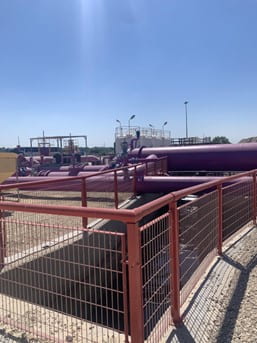
There is an internationally recognized coloring system for pipes that is used around the world. The purple color of these pipes indicate that they carry purified wastewater.

Erez Megidish, the lead process engineer at Shafdan, shows the group a model of the secondary bioreactor set up and explains how this part of the purification process works.
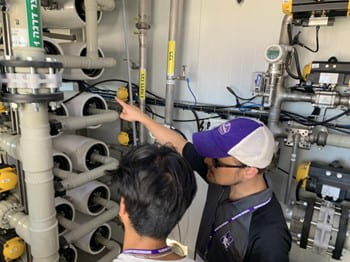
Professor George Wells (right) describes to Aidan Ocampo (left) the flow patterns of sea water through reverse osmosis filtration cartridges, which remove salt and other impurities from the water.
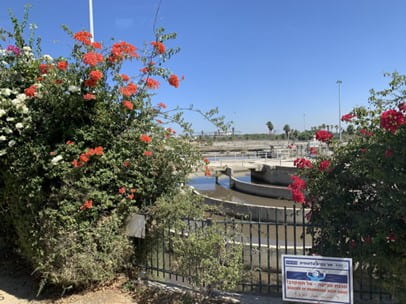
The bioreactor pools are surrounded by bushes of flowers, bringing an unexpected pop of color (and perhaps counter-scent) to the area.
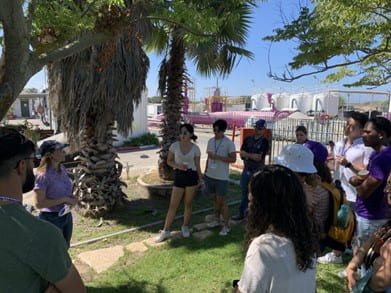
Another member of the Shadfan team talks to the group about the various pilot research facilities that are testing novel water treatment technologies at the facility.
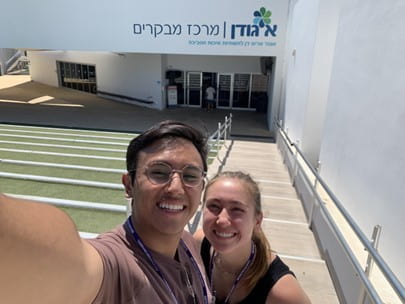
Kayd Bhagat and Molly Whalen (left to right) take a selfie in front of the Shafdan Water Treatment Visitor Center.
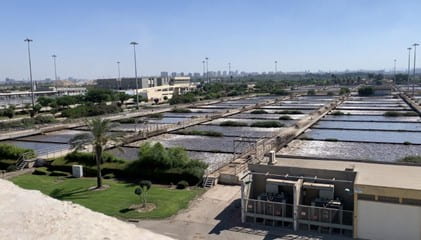
Wastewater flows through bioreactor pools where bacteria break down organic materials and harmful toxins in the water. The water becomes progressively cleaner the further it flows through the pools.
The Global Engineering Trek (GET) to Israel is jointly organized by the Northwestern Center for Water Research (NCWR) and the Israel Innovation Project (IIP). This program is focused on the topic of water (GET Water-Israel) and is offered to all first- and second-year Northwestern undergraduate students. GET Water-Israel is co-sponsored by McCormick Global Initiatives, the Institute for Sustainability and Energy at Northwestern (ISEN), the Crown Family Center for Jewish and Israel Studies, NCWR, and IIP.

